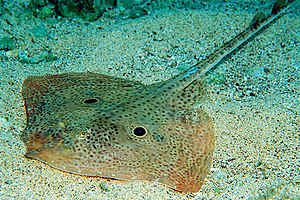Mirror rays
| Mirror rays | ||||||||||||
|---|---|---|---|---|---|---|---|---|---|---|---|---|

Mirror rays ( Raja miraletus ) |
||||||||||||
| Systematics | ||||||||||||
|
||||||||||||
| Scientific name | ||||||||||||
| Raja miraletus | ||||||||||||
| Linnaeus , 1758 |
The mirror ray ( Raja miraletus ), also known as the peacock's eye ray , belongs to the genus Raja and the family of real rays (Rajidae).
features
Broad, diamond-shaped body disc with rough skin along the indented front edge and in the head area. The snout is short and (especially in the males ) pointed. Edge of the pectoral fin (> wing <) almost rectangular. The eyes are bigger than the spray holes. The almost straight mouth opening and the five gill slits are on the belly side. 40 to 42 small teeth , pointed in the male, rounded in the female . Two dorsal fins of almost the same size, standing close together, on the end of the caudal peduncle. Very small caudal fin ; no anal fin . Slender, flat tail stalk (longer than half the body length) with a longitudinal row of 14 to 18 thorns, in the males with one, in the females with two further rows on each side; 2–3 spines between the dorsal fins. Some thorns close to the eyes, the males also with claw thorns on the front edge of the body disc and on the pectoral fins . Back side light brown, yellowish or gray with dark edges and small blackish brown dots (males also with yellowish dots), snout area lighter. In the middle of the lens two conspicuous, light blue eye spots (name!) With black-blue and yellow to orange-colored edges. Ventral side whitish. Maximum length 60 centimeters.
distribution
Eastern Atlantic , from southern Biscay to South Africa. Mediterranean (very common). In coastal waters, on sand or muddy bottom, mostly at a depth of 90–300 m.
Way of life
During the summer months they move into the shallow water zone and can then be found at a depth of 30 m, except for the eyes and spray holes. When alarmed, they swim with their pectoral fins moving vertically from front to back. Laying eggs ( oviparous ); the horny, rectangular egg capsules (4.2–5.2 cm long, 3–3.5 cm wide) with 2–3 cm long appendages at the corners are deposited in the Mediterranean during spring and in the Atlantic during the winter months.
food
Invertebrates and small bottom fish.
literature
- Josef H. Reichholf and Gunter Steinbach : The large Bertelsmann Lexikothek, Nature Encyclopedia of Europe, Volume 3, Fish; Freshwater and marine fish.
Web link
- Mirror rays on Fishbase.org (English)
- Raja miraletus inthe IUCN 2013 Red List of Threatened Species . Posted by: Smale, MJ, Ungaro, N., Serena, F., Dulvy, N., Tinti, F., Bertozzi, M., Mancusi, C. & Noarbartolo di Sciara, G., 2003. November 2013.